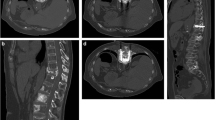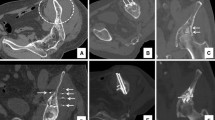Abstract
Objective
To evaluate feasibility, safety and efficacy of a combination of screw fixation and cementoplasty for pathologic bone fracture.
Methods
In this single-center prospective study, all consecutive percutaneous screw fixations under assisted CT guidance for palliation and fracture treatment of pathologic bone fracture were reviewed from July 2019 to February 2021. The primary outcome measure was the procedures’ technical success, defined as the correct placement of the screw(s), without any complications. Secondary outcome measures were the safety, the procedures’ early analgesic effects and impacts on quality of life at 4 weeks.
Results
Technical success was achieved in 11/11 procedures (100%) among 11 patients. No major complications attributable to the procedure were noted. The mean pain scored significantly decreased at the initial follow-up: 8.0 ± 2.7 versus 1.6 ± 2.5 (p < 0.05). Opioid doses were statistically lower after procedure: 70.9 ± 37 versus 48.2 ± 46 mg/day (p < 0.05). The mean EQ5D score had significantly increased by the early post-procedure consultation: 42.5 ± 13.6 vs 63.6 ± 10.3 (p < 0.05).
Conclusion
Combination of percutaneous screw fixation and cementoplasty for pathologic bone fracture is feasible and safe. It is efficient to reduce pain, decrease the consumption of opioids and improve the quality of life at 4 weeks after the procedure.

Similar content being viewed by others
Abbreviations
- CT:
-
Computed tomography
- CBCT:
-
Cone beam CT
- NPRS:
-
Numerical pain rate Score
- PS:
-
Performance status
- EQ5D:
-
EuroQol 5 dimensions
References
Coleman RE. Clinical features of metastatic bone disease and risk of skeletal morbidity. Clin Cancer Res. 2006;12:6243s–9s.
van den Beuken-van Everdingen MHJ, de Rijke JM, Kessels AG, Schouten HC, van Kleef M, Patijn J. Prevalence of pain in patients with cancer: a systematic review of the past 40 years. Ann Oncol. 2007;18:1437–49.
Mastier C, Gjorgjievska A, Thivolet A, Bouhamama A, Cuinet M, Pilleul F, et al. Musculoskeletal metastases management: the interventional radiologist’s toolbox. Semin intervent Radiol. 2018;35:281–9.
Ristevski B, Jenkinson RJ, Stephen DJG, Finkelstein J, Schemitsch EH, McKee MD, et al. Mortality and complications following stabilization of femoral metastatic lesions: a population-based study of regional variation and outcome. Can J Surg. 2009;52:302–8.
Basile A, Giuliano G, Scuderi V, Motta S, Crisafi R, Coppolino F, et al. Cementoplasty in the management of painful extraspinal bone metastases: our experience. Radiol med. 2008;113:1018–28.
Anselmetti GC, Manca A, Ortega C, Grignani G, DeBernardi F, Regge D. Treatment of extraspinal painful bone metastases with percutaneous cementoplasty: a prospective study of 50 patients. Cardiovasc Intervent Radiol. 2008;31:1165–73.
Kelekis A, Lovblad KO, Mehdizade A, Somon T, Yilmaz H, Wetzel SG, et al. Pelvic osteoplasty in osteolytic metastases: technical approach under fluoroscopic guidance and early clinical results. J Vasc Interv Radiol. 2005;16:81–8.
Lewis G. Properties of acrylic bone cement: state of the art review. J Biomed Mater Res. 1997;38:155–82.
Deschamps F, de Baere T, Hakime A, Pearson E, Farouil G, Teriitehau C, et al. Percutaneous osteosynthesis in the pelvis in cancer patients. Eur Radiol. 2016;26:1631–9.
Deschamps F, Farouil G, Hakime A, Teriitehau C, Barah A, de Baere T. Percutaneous stabilization of impending pathological fracture of the proximal femur. Cardiovasc Intervent Radiol. 2012;35:1428–32.
Deschamps F, Farouil G, Hakime A, Barah A, Guiu B, Teriitehau C, et al. Cementoplasty of metastases of the proximal femur: is it a safe palliative option? J Vasc Interv Radiol. 2012;23:1311–6.
Beckmann J, Springorum R, Vettorazzi E, Bachmeier S, Lüring C, Tingart M, et al. Fracture prevention by femoroplasty—cement augmentation of the proximal femur. J Orthop Res. 2011;29:1753–8.
Cazzato RL, Buy X, Eker O, Fabre T, Palussiere J. Percutaneous long bone cementoplasty of the limbs: experience with fifty-one non-surgical patients. Eur Radiol. 2014;24:3059–68.
Buy X, Cazzato RL, Catena V, Roubaud G, Kind M, Palussiere J. Techniques de consolidation osseuse guidée par imagerie en oncologie: cimentoplastie et vissage. Bull Cancer. 2017;104:423–32.
Cai L, Zhang Y, Zheng W, Wang J, Guo X, Feng Y. A novel percutaneous crossed screws fixation in treatment of Day type II crescent fracture–dislocation: a finite element analysis. J Orthop Transl. 2020;20:37–46.
Cornelis FH, Deschamps F. Augmented osteoplasty for proximal femur consolidation in cancer patients: biomechanical considerations and techniques. Diagn Interv Imaging. 2017;98:645–50.
Garnon J, Jennings JW, Meylheuc L, Auloge P, Weiss J, Koch G, et al. Biomechanics of the osseous pelvis and its implication for consolidative treatments in interventional oncology. Cardiovasc Intervent Radiol. 2020;43:1589–99.
Deschamps F, Yevich S, Gravel G, Roux C, Hakime A, de Baère T, et al. Percutaneous fixation by internal cemented screw for the treatment of unstable osseous disease in cancer patients. Semin Intervent Radiol. 2018;35:238–47.
Pusceddu C, Fancellu A, Ballicu N, Fele RM, Sotgia B, Melis L. CT-guided percutaneous screw fixation plus cementoplasty in the treatment of painful bone metastases with fractures or a high risk of pathological fracture. Skeletal Radiol. 2017;46:539–45.
Mavrovi E, Pialat J-B, Beji H, Kalenderian A-C, Vaz G, Richioud B. Percutaneous osteosynthesis and cementoplasty for stabilization of malignant pathologic fractures of the proximal femur. Diagn Interv Imaging. 2017;98:483–9.
Cazzato RL, Koch G, Buy X, Ramamurthy N, Tsoumakidou G, Caudrelier J, et al. Percutaneous image-guided screw fixation of bone lesions in cancer patients: double-centre analysis of outcomes including local evolution of the treated focus. Cardiovasc Intervent Radiol. 2016;39:1455–63.
Tian Q-H, He C-J, Wu C-G, Li Y-D, Gu Y-F, Wang T, et al. Comparison of percutaneous cementoplasty with and without interventional internal fixation for impending malignant pathological fracture of the proximal femur. Cardiovasc Intervent Radiol. 2016;39:81–9.
Roux C, Tselikas L, Yevich S, Sandes Solha R, Hakime A, Teriitehau C, et al. Fluoroscopy and cone-beam ct–guided fixation by internal cemented screw for pathologic pelvic fractures. Radiology. 2019;290:418–25.
Dassa M, Roux C, Tselikas L, Delpla A, Yevich S, Faron M, et al. Image-guided percutaneous fixation with internal cemented screws of impending femoral neck pathologic fractures in patients with metastatic cancer: safety, efficacy, and durability. Radiology. 2020;297:721–9.
Rabin R, de Charro F. EQ-SD: a measure of health status from the EuroQol Group. Ann Med. 2001;33:337–43.
Treillet E, Laurent S, Hadjiat Y. Practical management of opioid rotation and equianalgesia. JPR. 2018;11:2587–601.
Filippiadis DK, Binkert C, Pellerin O, Hoffmann RT, Krajina A, Pereira PL. Cirse quality assurance document and standards for classification of complications: the cirse classification system. Cardiovasc Intervent Radiol. 2017;40:1141–6.
Dindo D, Demartines N, Clavien P-A. Classification of surgical complications: a new proposal with evaluation in a cohort of 6336 patients and results of a survey. Ann Surg. 2004;240:205–13.
Hindiskere S, Kim H-S, Han I. Postoperative delirium in patients undergoing surgery for bone metastases. Medicine. 2020;99:e20159.
McNicol E. Opioid side effects and their treatment in patients with chronic cancer and noncancer pain. J Pain Palliat Care Pharmacother. 2008;22:270–81.
Acknowledgements
None.
Funding
The authors state that this work has not received any funding.
Author information
Authors and Affiliations
Contributions
SG, SB, SM and RG elaborated the project. SG, SB and SM collected the data. SB, SG and RG performed the procedure and wrote the manuscript. All authors managed the patients, corrected and validated the manuscript.
Corresponding author
Ethics declarations
Conflict of interest
No potential conflict of interest was reported by the authors.
Ethical approval
This study has obtained approval from local research committee (“terre d’éthique” CHU Saint-Etienne IRBN942019/CHUSTE). The "clinical trial" document has been completed (NCT05191264).
Informed consent
Informed consent was obtained from all individual participants included.
Additional information
Publisher's Note
Springer Nature remains neutral with regard to jurisdictional claims in published maps and institutional affiliations.
Rights and permissions
About this article
Cite this article
Bertholon, S., Grange, R., Thomas, T. et al. Combination of Percutaneous Screw Fixation and Cementoplasty for Lytic Bone Metastases: Feasibility, Safety and Clinical Outcomes. Cardiovasc Intervent Radiol 45, 1129–1133 (2022). https://doi.org/10.1007/s00270-022-03186-z
Received:
Accepted:
Published:
Issue Date:
DOI: https://doi.org/10.1007/s00270-022-03186-z




